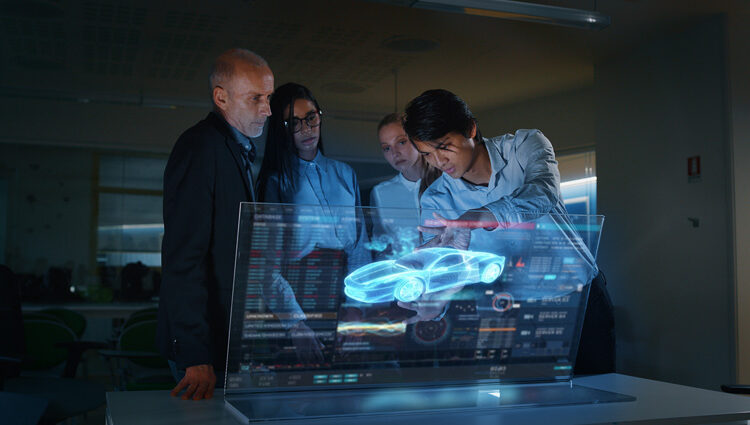The marketplace for Extended Reality is accelerating at an incredible pace. In virtually every industry, we’re seeing groups taking advantage of the unique benefits XR can offer. For the automotive industry, XR promises to change the way we travel forever.
In recent years, we’ve seen an increase in companies leveraging everything from virtual reality for digital product creation, to augmented reality for safer driving experiences. Used correctly, these incredible tools could be the key to building safer roads and airways.
Today, we’re going to be looking at some of the most incredible XR case studies worth reading in 2022, with a focus on automotive innovation.
Basemark and BMW
The future of driving could be forever changed by the collaboration between BMW and Basemark. In recent years, Basemark has contributed sensational AR applications and software to the BMW group, to help with the development of the new iX cars. These vehicles are set to use vehicle sensor data and computer vision technology to project crucial information on the car’s central information display via augmented reality.
According to Basemark, the augmented reality-powered central information display help with improving vehicle interaction and increasing the awareness drivers have of their surroundings. In BMW cars, Basemark technology can even place arrows in front of a driver’s vision to guide them in real-time to their destination. The features also help with facilitating better parking experiences in urban environments, with insights into everything from parking rates to available spaces.
Varjo and Kia
An innovator in the development of VR experiences for automotive training and development, Varjo has been assisting Kia in the creation of a new era of vehicles. According to Varjo, when the Kia experts tried a VR headset from Varjo for the first time, they were blown away by the depth of the visuals they could access.
With access to ultra-refined visualizes, the Kia team can use the Varjo VR environment to take their design work to new heights, creating photorealistic real-scale virtual car bodies. The immersive mixed reality experience also allows for in-depth collaboration between employees in a flexible, creative environment. Kia believes access to a VR landscape will empower teams to produce a higher-quality of modern car designs, at a faster pace.
Porsche and NSYNK
One of the major use cases for XR in the automotive industry, is the ability to introduce customers to cars with a “virtual showroom” experience. Some companies are even making it easier for customers to discover the various features of new vehicles at a distance, with AR technology. Porsche, and the MR experts, NSYNK, are working together to show potential customers behind the scenes of the latest Porsche cars.
For instance, with the Taycan AR event app, fans could look beneath the surface of an al-electric sports car, discovering what the vehicle really has to offer in a unique way. According to Porsche, this new approach to event-style AR applications has been crucial in recent years. AR ensures the team can connect with customers in an environment where live events aren’t always possible.
Lenovo, Varjo and Aston Martin
Another example of Varjo innovating with other brands in the automotive landscape, this case study on the partnership between Aston Martin, Lenovo, and Varjo is a must-read. As a company committed to creating the vehicles of the future for the drivers of today, Aston Martin is constantly looking into new and improved technology for ideation and discovery.
Aston Martin has partnered with Lenovo and Varjo to unlock the latest immersive experiences for both employees and customers alike. Aston Martin’s designers and developers can now leverage Lenovo and Varjo technology to build immersive digital versions of vehicles, for rapid creativity, and enhanced collaboration between distributed teams.
VIVE and Hyundai Motors
As a leader in the VR environment, VIVE has helped a number of leading car brands to discover new methods of innovation and ideation in the virtual landscape. Hyundai Motors is just one excellent example. The Hyundai team leveraged HTC Vive Pro Eye Headset, and the Autodesk VRED to support teams in a distributed environment to collaborate over car design.
The innovative offering meant 20 designers, engineers, and key stakeholders could log into virtual environments at the same time to discuss, revise, and review various aspects of a vehicle. What’s more, the simple and intuitive controls meant teams could access everything from high-fidelity renderings of the car’s interior to views of what the car might look like in different colours.
Microsoft and Mercedes
Mercedes has long stood out as a global icon in luxury automotive design. The company is committed to delivering the best possible customer experience, both with sensational service, and cutting-edge design. To achieve its goals in recent years, the brand has begun experimenting with new and improved tools for innovation and creativity, like the HoloLens 2, from Microsoft.
With access to Microsoft HoloLens 2 technology and Dynamics 365 Remote Assist technologies, Mercedes can now use the power of Mixed Reality to enhance technician efficiency. Together, Microsoft and Mercedes are reducing the time to problem resolutions and minimizing the costs and environmental impacts associated with service-related travel.
Oculus and Aptiv
As mentioned above, a major selling point for the use of XR in automotive environments, is the ability of the technology to provide immersive and powerful training experiences, in a virtual, safe environment. Aptiv, a company committed to make vehicles safer and greener, recently leveraged technology from the Meta and Oculus team to bring virtual reality into their processes.
The Aptiv team, alongside the Gemba virtual reality learning platform and Oculus, built a virtual environment where professionals could access sensational driver-focused education experiences. Not only were the experiences deeply immersive, but they also helped to reduce in-person training requirements from two days, to only four hours.

